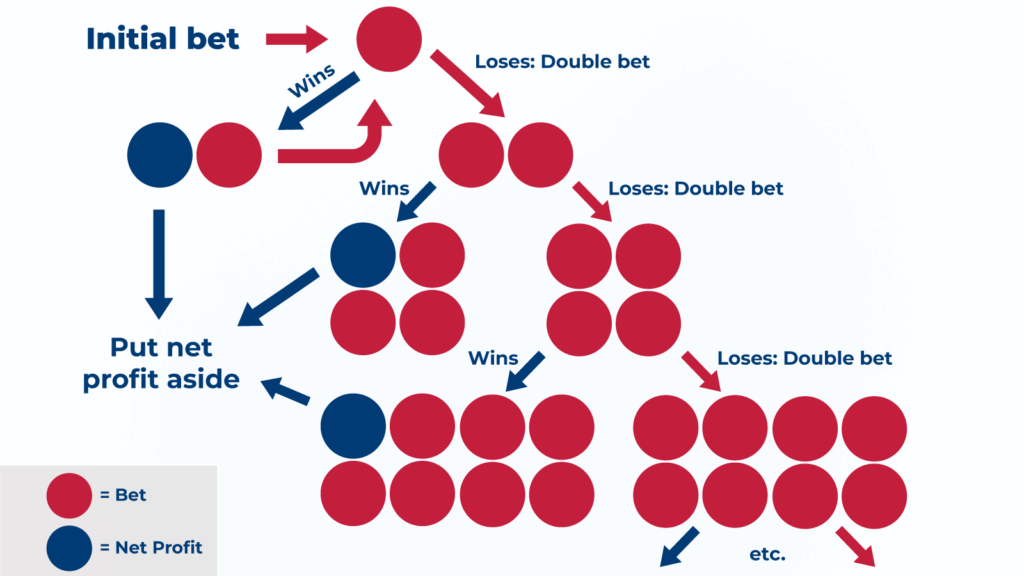Are you tired of leaving the roulette table empty-handed? Are you looking for a strategy that can help you dominate the game and walk away as a winner? Look no further than the Martingale Strategy. This age-old strategy has been used by gamblers for centuries, and with the right knowledge and execution, it can be a game-changer.
In this guide, we will take you through the ins and outs of the Martingale Strategy, providing you with insider tips and tricks that will give you the upper hand at the roulette table.
From understanding the concept behind the strategy to implementing it effectively, we will cover it all. Whether you’re a seasoned player or a beginner looking to up your game, mastering the Martingale Strategy will give you the confidence and skills needed to dominate the roulette table and come out on top.
So, get ready to spin the wheel and take your gambling skills to the next level with this winning strategy.
How the Martingale Strategy works?
The Martingale Strategy is a progressive betting system that is primarily used in games of chance, such as roulette. The concept is simple: you double your bet after every loss until you win, aiming to recoup all your previous losses and make a profit.
The idea behind the Martingale Strategy is that statistically, in the long run, you are bound to win eventually. By doubling your bet after each loss, you increase the potential payout and cover your previous losses when you eventually win. This strategy is based on the assumption that losing streaks are temporary, and a win will eventually occur.
However, it’s essential to note that the Martingale Strategy does not guarantee a win every time. It is a high-risk strategy that requires careful consideration and proper bankroll management. Let’s explore the pros and cons of this strategy in more detail.

Pros and cons of the Martingale Strategy
The Martingale Strategy has its advantages and disadvantages, and understanding them is crucial before implementing it at the roulette table.

Pros:
1. Simplicity: The Martingale Strategy is easy to understand and implement, making it suitable for both beginners and experienced players.
2. Potential for high winnings: If luck is on your side and you hit a winning streak, the Martingale Strategy can lead to significant profits.
3. Quick recovery from losses: With each win, you recoup all your previous losses, ensuring that you stay in the game even after a series of losses.
Cons:
1. Risk of substantial loss: The Martingale Strategy carries a significant risk of losing a large sum of money, especially if you encounter an extended losing streak.
2. Table limits and bankroll limitations: Many casinos have table limits, which can restrict the effectiveness of the Martingale Strategy. Additionally, if you have a limited bankroll, you may not have enough funds to cover consecutive losses.
3. False sense of security: While the strategy may work in theory, it’s important to remember that each spin of the roulette wheel is an independent event. Just because you have experienced a series of losses does not mean that a win is imminent.
Common mistakes to avoid when using the Martingale Strategy
While the Martingale Strategy can be an effective betting system when used correctly, many players make common mistakes that can lead to significant losses. By avoiding these pitfalls, you can increase your chances of success.
1. Doubling your bet indefinitely: It’s crucial to set a limit on how many times you will double your bet. If you hit that limit without a win, it’s time to walk away from the table. Doubling your bet indefinitely is a recipe for disaster, as it can quickly deplete your bankroll.
2. Ignoring table limits: Before you start playing, make sure to check the table limits. If the maximum bet allowed is too low, it may not be possible to effectively implement the Martingale Strategy. Look for a table with higher limits to give yourself more room for progression.
3. Chasing losses: After a series of losses, it’s easy to become frustrated and start increasing your bet size out of desperation. This is a dangerous mindset that can lead to even more significant losses. Stick to your predetermined betting progression and avoid chasing losses.
4. Not practicing proper bankroll management: One of the most critical aspects of using the Martingale Strategy is managing your bankroll effectively. Set a loss limit and stick to it. Don’t risk more money than you can afford to lose.
5. Failing to understand the odds: Roulette is a game of chance, and each spin of the wheel is independent of the previous spin. It’s essential to understand that the Martingale Strategy does not alter the odds of the game. It can only provide a betting system to potentially capitalize on winning streaks.
By avoiding these common mistakes, you can maximize your chances of success when implementing the Martingale Strategy. However, it’s important to consider alternative strategies as well. Let’s explore some options.
Alternative strategies to consider for roulette
While the Martingale Strategy is one of the most popular and widely known betting systems for roulette, it’s not the only strategy available. Depending on your risk tolerance and playing style, you may find these alternative strategies more suitable:
1. D’Alembert Strategy: Similar to the Martingale Strategy, but with a milder progression. Instead of doubling your bet after each loss, you increase it by a smaller amount. This strategy aims to provide more stability and slower progression. Read more about D’Alembert strategy for roulette here.
2. Fibonacci Strategy: This strategy is based on the Fibonacci sequence, where each number is the sum of the two preceding ones. In roulette, you use the sequence to determine your bet size. If you lose, you move one step forward in the sequence, and if you win, you move two steps back. Discover more about Fibonacci strategy for roulette here.
3. Labouchere Strategy: Also known as the cancellation system, this strategy involves creating a sequence of numbers that represents your desired profit. Each bet you place is the sum of the first and last numbers in the sequence. If you win, you cross out those numbers, and if you lose, you add the amount of your bet to the end of the sequence. Here you can discover more about Labouchere strategy in roulette.
These alternative strategies provide different approaches to betting in roulette and may suit different playing styles or risk preferences. It’s important to experiment and find the strategy that works best for you.
Understanding the odds and probabilities in roulette
To effectively implement any betting strategy, it’s crucial to have a solid understanding of the odds and probabilities in roulette. The game consists of various types of bets, each with its own odds and payouts.
The most common types of bets in roulette are:
1. Inside bets: These bets are placed on individual numbers or a combination of numbers within the inner grid of the roulette table. The odds of winning an inside bet are lower, but the payouts are higher.
2. Outside bets: These bets are placed on larger groups of numbers, such as odd or even, red or black, or high or low. The odds of winning an outside bet are higher, but the payouts are lower.
3. Column bets: These bets are placed on one of the three columns of numbers on the roulette table. The odds and payouts for column bets are similar to outside bets.
By understanding the odds and payouts for each type of bet, you can make more informed decisions when implementing the Martingale Strategy. It’s important to remember that no strategy can alter the inherent odds of the game, but they can help you manage your betting progression.
Bankroll management for the Martingale Strategy
Proper bankroll management is essential when using the Martingale Strategy. Without a well-managed bankroll, you run the risk of depleting your funds quickly and potentially losing more money than you can afford.
Here are some tips for effective bankroll management:
1. Determine your session bankroll: Before you start playing, decide how much money you are willing to risk per session. This should be an amount that you can afford to lose without impacting your financial well-being.
2. Divide your bankroll into units: Divide your session bankroll into smaller units. Each unit will represent the minimum bet at the table you are playing. This will help you keep track of your betting progression and ensure that you can cover consecutive losses.
3. Set a loss limit: Determine the maximum number of units you are willing to lose in a session. Once you reach this limit, it’s time to walk away from the table. This will help protect your bankroll from substantial losses and prevent you from chasing losses in a desperate attempt to recover.
4. Set a win goal: Similarly, set a target for the number of units you aim to win in a session. Once you reach this goal, it’s important to have the discipline to walk away and secure your winnings. Greed can be a gambler’s worst enemy, so stick to your predetermined win goal.
By practicing proper bankroll management, you can mitigate the risks associated with the Martingale Strategy and ensure that you can enjoy the game of roulette responsibly.
Real-life success stories using the Martingale Strategy
While the Martingale Strategy is not without its risks, there have been real-life success stories of players who have used this strategy effectively and walked away with substantial winnings. These stories serve as inspiration and a reminder that, with the right approach, the Martingale Strategy can be a powerful tool.
One famous example is Charles Wells, who in 1891, broke the bank at the Monte Carlo Casino using the Martingale Strategy. He started with a modest bankroll and went on a winning streak that allowed him to amass a fortune. However, it’s important to note that these success stories are the exception rather than the norm. For every Charles Wells, there are countless others who have experienced significant losses.
The key to success with the Martingale Strategy lies in understanding its limitations and implementing it responsibly and with discipline. It’s not a guaranteed path to riches, but with proper bankroll management and a bit of luck, it can enhance your chances of coming out ahead.
Conclusion and final thoughts about Martingale Strategy in roulette

The Martingale Strategy has stood the test of time as one of the most popular and widely used betting systems in roulette. While it can be an effective tool for capitalizing on winning streaks, it’s crucial to approach it with caution and understand the risks involved.
By understanding how the Martingale Strategy works, weighing its pros and cons, implementing it effectively, avoiding common mistakes, and practicing proper bankroll management, you can increase your chances of success at the roulette table.
Remember, gambling should always be approached responsibly, and no strategy can guarantee a win. The Martingale Strategy is just one tool in a player’s arsenal, and it’s important to consider alternative strategies and understand the odds and probabilities of the game.
So, next time you find yourself at the roulette table, armed with the knowledge and insights from this guide, take a deep breath, stay focused, and may Lady Luck be on your side as you master the Martingale Strategy and dominate the roulette table. Happy gambling!